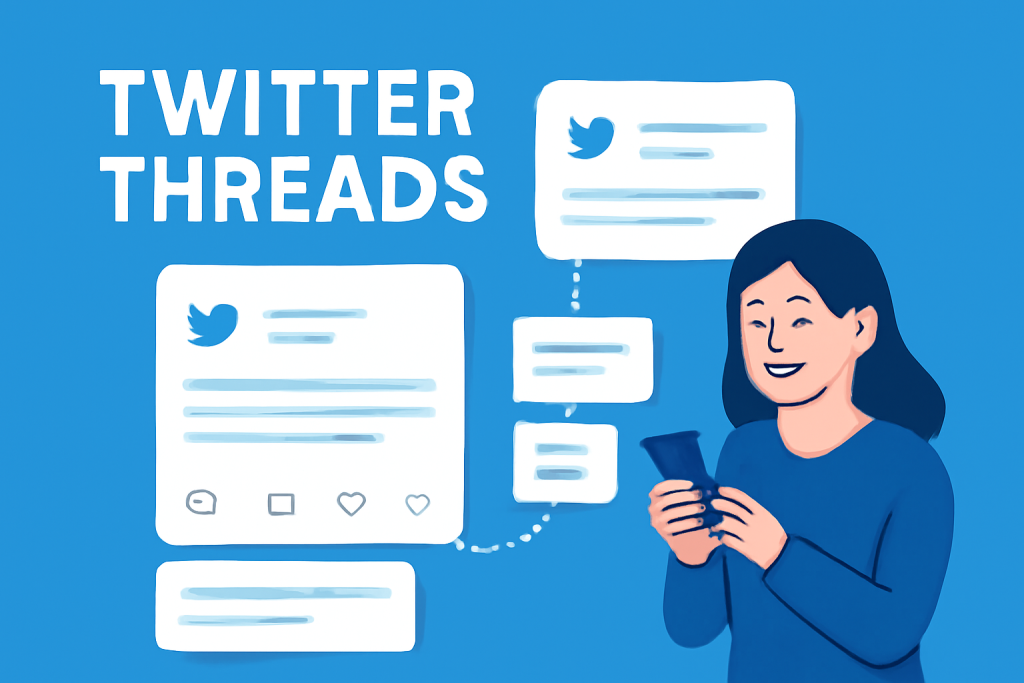Twitter threads have become one of the most popular ways to share longer, more detailed content on the platform. While a single tweet can quickly convey a thought or opinion, a thread allows you to expand on that idea, tell a story, or dive deep into a subject. The potential for viral Twitter threads is huge—when done correctly, they can boost your visibility, attract new followers, and increase engagement.
In this blog, we’ll explore why Twitter threads go viral, key elements that make a thread successful, and examples to help inspire your own content. We’ll also share some actionable tips to help you create engaging and shareable Twitter threads that can go viral.
Why Twitter Threads Go Viral

What makes a Twitter thread go viral? It’s not just about posting a lot of tweets in a row; it’s about crafting content that people find interesting, valuable, and worth sharing. Twitter threads that go viral often combine elements of storytelling, humor, education, and engagement.
Here’s why threads tend to spread:
- Shareability: People love to share content that speaks to them emotionally, educates them, or gives them new insights. A thread can build a narrative that people want to pass along to their followers.
- Curiosity and Suspense: If a thread opens with an intriguing statement or a hook, people want to know what happens next, driving them to read all the way through.
- Relatability: People are more likely to engage with a thread if it resonates with their own experiences, feelings, or challenges.
The beauty of a viral Twitter thread is its ability to reach far beyond your immediate followers, gaining exposure to new audiences and providing value that encourages others to engage, comment, or share.
Key Elements of a Viral Twitter Thread
Creating viral Twitter threads isn’t just about writing; it’s about writing well. There are a few key elements that make a thread irresistible and encourage more interactions.
1.) Clear and Engaging Opening
Your opening tweet needs to grab attention instantly. Start with a hook that makes people want to read more. It could be a bold statement, a question, or a surprising fact. The goal is to spark curiosity and convince people to continue reading.
Example:
“Ever wondered why some Twitter threads go viral while others flop? Here’s the secret.”
2.) Storytelling Approach
The best threads tell a story—whether it’s personal, educational, or a thought-provoking narrative. People love following a storyline because it keeps them engaged. Make sure your thread has a clear beginning, middle, and end. Try to evoke emotions or challenge your audience’s perspective.
3.) Brevity with Depth
Each tweet in the thread should be short and easy to digest, but also rich in information. Don’t overwhelm readers with huge chunks of text. Break down complex ideas into bite-sized, digestible pieces while maintaining depth in your content.
4.) Call to Action (CTA)
Don’t forget to include a call to action in your thread. Whether it’s asking readers to comment with their thoughts, retweeting to share the message, or following you for more content, a CTA encourages readers to engage further.
5.) Timing and Trends
Capitalizing on trending topics or current events can make your Twitter thread more timely and relevant. If your thread ties into something happening in the world or in your industry, it’s more likely to resonate with a wider audience. Trending hashtags or hot topics are a great way to increase your thread’s visibility.
How to Structure Your Twitter Thread for Maximum Engagement
It’s not just what you write, but how you structure it. A well-organized Twitter thread will keep readers engaged from start to finish. Here’s how to structure your thread for the best results:

a.) Start with a Hook
Your first tweet should make people want to click “Read More.” This is your chance to pull them in with something intriguing. Use a provocative question, an unexpected fact, or a bold statement to get attention.
Example:
“Here’s how I went from 100 to 10,000 Twitter followers in just 3 months. (Yes, it’s possible!)”
b.) Building Curiosity
As you continue your thread, keep the readers’ curiosity alive. Use statements that prompt people to keep reading. For example, you could tease the next tweet with a cliffhanger or promise more valuable content in the next part of the thread.
c.) Value-Driven Content
Offer something valuable to your audience. Whether you’re sharing personal experiences, actionable tips, or educational insights, ensure that each tweet delivers something worth reading. People share content that benefits them, so provide something that your audience can learn or apply.
d.) Flow Between Tweets
Make sure your tweets follow each other logically. There should be a smooth transition from one tweet to the next, creating a natural flow. Number your tweets or use simple phrases like “Next” or “Let’s dive deeper” to keep readers engaged.
e.) Ending with Impact
The last tweet should leave a lasting impression. Wrap up your thread with a strong, actionable message. You could offer a call to action (e.g., “What’s your favorite Twitter tip? Let me know in the comments!”), summarize key points, or share a thought-provoking statement.
Viral Twitter Thread Examples to Inspire You
Here are some examples of viral Twitter threads that took off because they were well-crafted, engaging, and offered value:
- Example 1: A thread explaining how a popular trend in technology will impact the future. The thread used clear language, simple examples, and was timely.
- Example 2: A personal success story shared by an entrepreneur who built a successful business from scratch. The thread had a lot of heart, and readers resonated with the journey.
- Example 3: A thread analyzing a controversial opinion in the news. It sparked discussions and debates, drawing in people with diverse perspectives.
- Example 4: A detailed tutorial on how to improve productivity. It included step-by-step tips that people found useful and shared with others.
Best Practices for Creating Viral Twitter Threads
Once you’ve got the hang of crafting engaging threads, here are some best practices to keep in mind for maximum reach:
1. Use Strong Visuals
A thread that includes images, GIFs, or videos is more likely to stand out in a sea of text-based tweets. Visuals make your thread more appealing and can help illustrate complex ideas.
2. Be Consistent
If you post threads regularly, you’ll start to build an audience that expects your content. Consistency helps you grow your presence on Twitter and increases your chances of going viral.
3. Engage with Your Audience
Don’t just post and forget about it. Respond to comments, engage in conversations, and interact with those who retweet or comment on your thread. Engagement keeps the thread alive and increases its reach.
4. Hashtags & Mentions
Using relevant hashtags can increase your thread’s visibility, especially if it’s tied to a current trend or topic. Also, mention influencers or industry experts who might be interested in your thread, increasing the chances of them engaging with your content.
5. Be Authentic
People appreciate authenticity. Share your real experiences, thoughts, and opinions. Authenticity makes your content relatable and encourages engagement.
Common Mistakes to Avoid in Twitter Threads
While creating viral Twitter threads is an art, there are a few common mistakes that can ruin your chances of going viral:
– Overloading with Information
Don’t overwhelm your audience with too much information. Threads should be easy to follow. Stick to one main idea per tweet and break up complex content.
– Lack of Structure
A disorganized thread can confuse readers. Each tweet should flow logically into the next, with a clear start and finish.
– Ignoring Engagement
Don’t neglect the comments and retweets. Engage with your audience to keep the conversation going and show that you value their input.
– Being Too Promotional
Focus on offering value. Twitter threads that are overly promotional tend to get ignored. Instead, share insights, ideas, and useful content, and let people naturally be drawn to your services or products.
How to Measure the Success of Your Twitter Thread
Once your thread is live, it’s important to track its success. Here’s how to measure your thread’s performance:
1. Tracking Engagement
Look at the number of likes, retweets, comments, and shares. Engagement is the best indicator of whether or not your thread is resonating with your audience.
2. Using Analytics Tools
Tools like Twitter Analytics or third-party apps can give you more detailed insights into your thread’s reach and impact. You can track how many people saw your thread, who engaged with it, and where your audience is coming from.
3. Feedback and Iteration
Learn from your results. If a thread performs well, analyze what made it successful and try to replicate it in future threads. If it doesn’t, adjust your approach based on the feedback.
Conclusion
Twitter threads are a powerful tool for sharing valuable content, increasing engagement, and gaining visibility on the platform. By following the tips and examples shared in this blog, you can craft viral Twitter threads that resonate with your audience and encourage shares and comments.
So, what are you waiting for? Start experimenting with your own Twitter threads today, and don’t forget to share your best ones with us!

